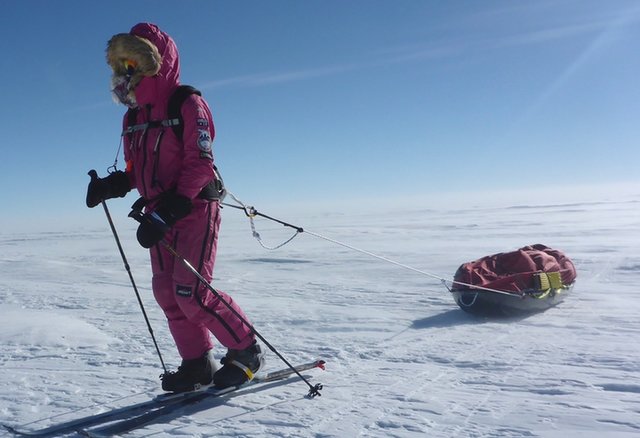Bottomlessicepitsbeneaththinlayersofsnow.Sharpiceridges,oneafteranother,likefrozenwavesacrosstheland.Howlingwindsandblowingice crystals.
JadeHameisterknewherSouth Polejourneywouldbehard.Butsheneverimagineditwouldbethisunforgiving.Shebentintothewindandstrainedtopulltheheavysupplysledstrappedtoherwaist.Allshecoulddowasputoneskiinfrontoftheother,onesmallstepata time.

Jadehauledherheavysledintostrong winds.
Jade'sbreathfrozeonherface mask.


Jadestruggledtodraghersledoverthe ice.
ForgingaPath
JadehadalreadycompletedtwopartsofthedemandingPolarHatTrick.ShehadskiedtotheNorthPoleandacrossGreenland.ThisSouthPoleadventurewouldbethefinalchallenge.HardlyanyonehadtriedtodowhatJadewasattemptingnow.Shewasonly16.Only140peoplehaveeverskiedwithoutassistancefromtheAntarcticcoasttotheSouthPole.Andonly20ofthesewere women.
Jade’steamwouldtravelundertheirownmusclepower,withoutsleddogsorvehicles.Nosupplieswouldbeairliftedtothem.Everythingtheyneededfortheestimated40dayshadtobeloadedontosledsandhauled.Withfood,campstovesandfuel,clothing,tents,andequipment,eachsledweighedmorethan80 kilograms (176 pounds).
Ifthiswasn’tenough,Jadeandherteamtookonanaddedchallenge.TheywantedtotakeanewroutetotheSouthPole.Theystudiedmapsandfoundacoast‑to-poleroutethatnoonehadevertaken.Thiswouldtakethemthroughsteep,challengingterrain.They’dskiacrosstheKansasGlacierandthroughtheTransantarcticMountainsthatdivideeastandwest Antarctica.
Theteamhadtocarryorpulleverythingthey needed.